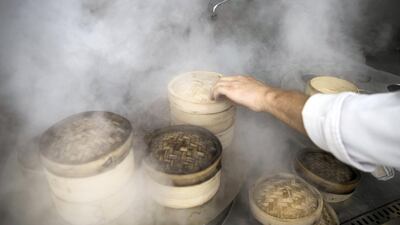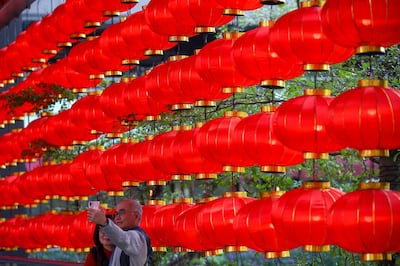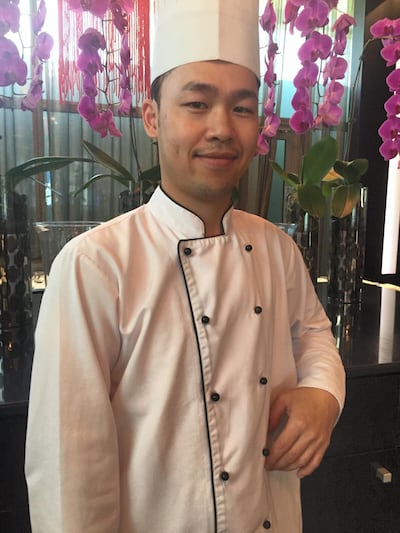The Year of the Dog has dawned. Today marks a new year in the Chinese calendar – one of the world's most colourful, exuberant and traditional events, triggering celebrations in Chinese communities across the world.
Also known as the Spring Festival, it is the grandest traditional Chinese holiday and a time for family.
The reunion dinner
As with all great celebrations, festivities centre on the food. The banquet of delicious dishes to mark Chinese New Year's Eve precedes celebrations that ensue for the next two weeks.
Last night, families celebrating across the globe sat down together to share a meal rife with customs and tradition. Called the reunion dinner, it is one of the most important meals for Chinese families, says Andy Toh Chye Siong, the executive chef for Hakkasan in the Middle East.
The dinner triggers China’s biggest temporary migration every year, as people travel across the country to reunite with their families for this, the single most auspicious evening of the year.
His mother, he says, was not happy to learn that he, along with his wife and their four sons, would be unable to leave Dubai this year to join the rest of their family.
"All the family members go back to their home for the reunion dinner – it is tradition. All believe that family members need to sit down together for good luck.
"If any are not back, that means he has been eaten by a lion – that is what my mother told us growing up," he laughs.
Because of the industry he works in, this is his busiest day of the year, so taking the time to head home is almost impossible.
“Over the years, traditions have changed,” he says. “Although my mother still wants to cook for her family at home, most people now eat out for reunion dinner.
"When I was young, a lot of Chinese restaurants did not even open for New Year's Eve or even the first two days [of the new year]."
The traditional dishes
Like so many other Chinese festivals, New Year is celebrated with plenty of food. But for the Cantonese, the food that is eaten also carries special meaning, carefully chosen because of beliefs that it will usher in good luck, wealth, better grades and the like.
A number of dishes will be ubiquitous at dinner tables in Cantonese households and restaurants during Chinese New Year.
The reunion dinner usually features dishes with carefully chosen ingredients that sound or look auspicious, says Michael Teng, owner of three popular Chinese restaurants in the UAE: the Dragon Seeds in Academic City and Noodle Bowl in Zayed Sports City's bowling centre in Abu Dhabi and in Satwa in Dubai.
Teng, a Chinese-Canadian, says that eating sweet dishes during New Year, such as the glutinous rice cake that will be served at Dragon Seeds or sweet dumplings filled with sesame paste and served in a sugar syrup, have meanings for the year ahead.
“The dumplings represent wealth because of their resemblance to gold ingots, a currency that was used during the Tang dynasty and beyond,” he explains.
Robert Li Wei, a chef at Innlay Asia in JLT in Dubai, who prides himself on mastering a variety of South East Asian cuisines, will be using pomelo in one of his salads for the reunion dinner.
Pomelo, he says, which in Cantonese is pronounced as "luk jau", suggests continuous prosperity because the two syllables are homophones for "rolling" and "to have".
Ingredients such as lettuce ("sang choi") and dried oysters ("ho si") are also popular ingredients because they respectively sound like "growing money" and "good things".
Similarly, Hakkasan's menu for Chinese New Year this year, created by its chefs from across the world and available until March 4, features dishes that all use ingredients thought to bestow happiness, longevity, luck and prosperity, such as Szechuan wind-dried oyster with lotus root and crispy rice in mantou – oysters traditionally symbolising fortune and good luck.
Hakkasan chef Siong is a fan of the abalone fried rice in bean curd wrap with mushroom, which contains fai cai (fat choy), an ingredient which in Chinese means to “get rich and grow wealth”.
____________________
Read more about the Lunar New Year:
Chinese New Year 2018: what it is and how to celebrate it
Ten to try: the best Chinese eateries in Abu Dhabi and Dubai
Celebrate Chinese New Year with light show at the Burj Khalifa
7 places to celebrate the Chinese New Year in the UAE
____________________
The red envelopes
Zhu, head chef at Dragon Seeds in Academic City, is from Anhui, an eastern Chinese province.
Growing up, the Chinese New Year tradition of younger family members receiving gifts of cash in red envelopes, a practice known as “hongbao”, was always his favourite.
“The money we put in the envelopes is not a huge amount,” he says. “It is meant to be symbolic – it protects children from evil and keeps them healthy, and for adults, it is for good fortune.”
Every year, Siong gives his four sons the "hongbao" gifts, as well as to his staff and their children, to mark the tradition. "Now, with my older sons, they just wait for the red envelope for Chinese New Year," he says.
In his childhood, however, the money in that envelope meant heading to the store with his friends to buy drinks and sweets and firecrackers. “And we always got new clothes to wear for Chinese New Year, like so many other families,” he recalls. “It’s an exciting time for children.”
The decor
The colour red symbolises good fortune in Chinese culture, and Chinese homes will hang red cloths above their front doors and decorate inside their homes with red items, explains Fan, Dragon Seeds' dim sum chef, who hails from south-eastern Chinese province Fujian.
Zhu makes all of the restaurant's dumplings and noodles from scratch, and has garnered a fan base thanks to his dim sum's authenticity.
“We will decorate with paper lanterns and place paper logos around the house that have on them different words to mean fortune and luck,” he says. “Red for Chinese is luck, so many will wear red clothing as well.”
Growing up, Zhu remembers that his mother decorated their home on the eve of Chinese New Year, a few hours before the reunion dinner. "It is better not to tempt bad fortune and be too eager to decorate; you must do it only one day before the start of the two-week festivities," he says.
The traditions
Hakkasan will invite guests to write their wishes on red ribbons to be hung around the dining areas in their restaurants.
This custom is said to have begun hundreds of years ago in Lam Tsuen, Hong Kong, explains Siong.
During Chinese New Year, villagers would travel for many kilometres to visit the sacred Lam Tsuen Wishing Trees, two ancient banyan trees, and hang notes on the branches using red ribbons.
These notes contained wishes for the year ahead, and it was believed that those that were hung on the trees would come true.
The Chinese are very family orientated, says Amy Xinyu Stli, manager of the Beijing restaurant in Abu Dhabi'sAl Zahiyah. She recalls the days following Chinese New Year as a whirlwind of social visits as a girl growing up in Dalian in northern China, when for two weeks, friends and relatives would visit to wish each other good fortune and to exchange the hongbao envelopes.
“It is a beautiful and very important time of the year for us,” she says. “It is a time of family, and when family come together, there is always good food.”
Happiness on the menu
Da Ni Yong, head chef at the Royal China restaurant in DIFC, grew up in the town of Guang Xi in southern China.
His love for cooking stemmed from watching his father in the kitchen, preparing food for the family. Cooking, he says, no matter what the cuisine, is about choosing and using the right ingredients that blend well to create outstanding flavour.
“I personally believe that dishes should not be too dominant nor too bland when it comes to flavour,” he says. “They should rather be delicately balanced.”
For Yong, Chinese New Year is about a family feast. “One of the strongest memories I have is hanging the iconic red lanterns, then our whole family would come together for an opulent feast on a traditional round table.”
His father would prepare that meal, too. “He would make an abundance of dishes,” the chef says. “Favourites such as steamed fish and double boiled chicken and a hearty mushroom soup. Our feast would always end with a delicious dessert such as sticky rice dumpling in red bean pastry soup.”
A favourite dish from childhood, Yong says, is steamed whole fish served with ginger and spring onion. It is a dish that he associates with happy memories, so it was a no-brainer to include in the Royal China menu, especially for Chinese New Year, because fish symbolises abundance for the Chinese.
The idea is that if you’ve saved enough this year, you can make more of whatever comes at you in the next year,” he explains. “Luckily, this means I get to prepare this favourite fish and eat it. It was a signature dish of my father, making it a very special item for me.”
Another must-have for an authentic Chinese New Year feast, he adds, besides spring rolls and dumplings, is the yee sang or lo hei, also known as the Chinese New Year prosperity salad or lucky salad, a Cantonese-style raw fish salad that originated from the Cantonese phrase “to toss up good fortune”. It is also known as yu sheng in Mandarin, and it will be served at Dragon Seeds in Dubai and at Beijing restaurants across Abu Dhabi.
“It is said that eating it brings a prosperous and lucky year,” the chef says.
The dish is made with julienned daikon radish, carrots, ginger, pickled spring onions, cucumber, crispy fried dough croutons, seaweed, Chinese pear and raw fish such as salmon or yellowtail. The salad is dressed with crushed peanuts, sesame seeds, five-spice powder, plum sauce and sesame oil.
Royal China will be serving the dish as part of its special, two-week-long New Year menu. The salad is usually served on a large platter, with the star ingredient – the raw fish – added at the table. Everyone around the table has to stand up and use their chopsticks to mix and toss the salad. As you toss the salad, you shout out your wishes for the year ahead.



